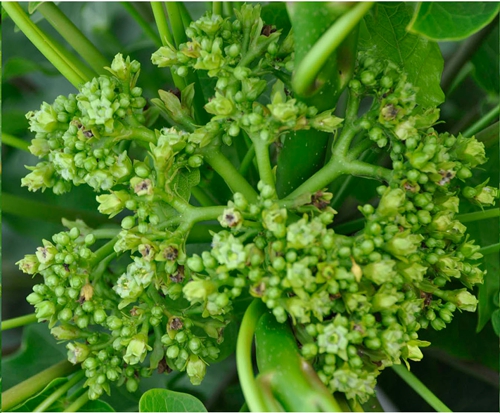Prof. XU Zengfu’s team of Xishuangbanna Tropical Botanical Garden (XTBG) has been engaged in studying Jatropha curcas L, a potential biofuel plant, over the past few years. Their previous study showed that the application of exogenous cytokinin (6-benzyladenine, BA) on flower buds significantly increased the total number of flowers and the proportion of female flowers in J. curcas to improve seed yield. To understand the molecular mechanism of cytokinin action in J. curcas inflorescence buds, they analyzed the dynamic changes of gene expression at different time points (0, 3, 12, 24, and 48h) after BA treatment using a microarray method. In total, 5,555 differentially expressed transcripts were identified, which belonged to 32 gene ontology categories with 12 distinct expression patterns. Moreover, exogenous BA influenced the effects of major phytohormones by modulating the expression levels of genes involved in various metabolic pathways in J. curcas. These phytohormones may jointly regulate the development of J. curcas flowers after BA treatment, although their exact roles in this process remain to be defined. Elucidating the mechanisms of cross-talk among multiple signaling pathways is also essential. Based on the analysis of genes involved in flowering and phytohormone signaling pathways, the researchers hypothesized that BA treatment could delay the formation of floral organs by repressing the expression of A, B and E class genes. These genes played important roles in the formation of floral organ and maintaining flowering time by regulating the transcription of genes involved in flowering signaling pathway to generate more shoot apical meristem (SAM) cells in inflorescences. Thus, more shoot apical meristem cells would be generated in inflorescences to produce more flowers in J. curcas. The study provides a basis for understanding the molecular mechanisms of inflorescence development in response to cytokinin treatment in J. curcas, and offers useful information on the study of molecular links among multiple hormone signaling pathways in woody plants. The study entitled “Analysis of the transcriptional responses in inflorescence buds of Jatropha curcas exposed to cytokinin treatment” has been published in BMC Plant Biology. 
Inflorescence of Jatropha curcas (Image by CHEN Maosheng) |

